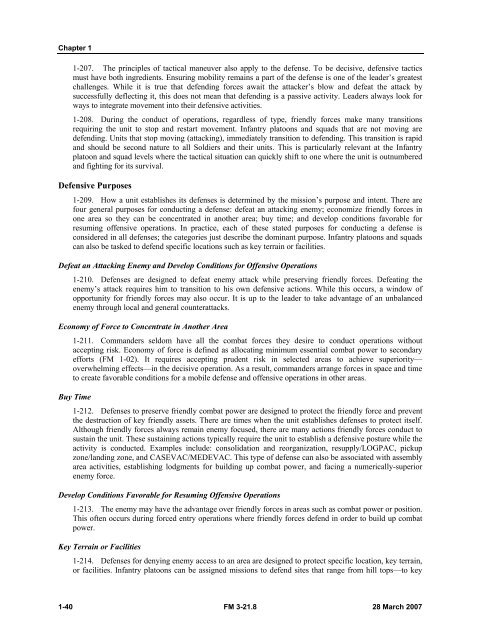Infantry Rifle Platoon and Squad - Sakai
Infantry Rifle Platoon and Squad - Sakai
Infantry Rifle Platoon and Squad - Sakai
You also want an ePaper? Increase the reach of your titles
YUMPU automatically turns print PDFs into web optimized ePapers that Google loves.
Chapter 1<br />
1-207. The principles of tactical maneuver also apply to the defense. To be decisive, defensive tactics<br />
must have both ingredients. Ensuring mobility remains a part of the defense is one of the leader’s greatest<br />
challenges. While it is true that defending forces await the attacker’s blow <strong>and</strong> defeat the attack by<br />
successfully deflecting it, this does not mean that defending is a passive activity. Leaders always look for<br />
ways to integrate movement into their defensive activities.<br />
1-208. During the conduct of operations, regardless of type, friendly forces make many transitions<br />
requiring the unit to stop <strong>and</strong> restart movement. <strong>Infantry</strong> platoons <strong>and</strong> squads that are not moving are<br />
defending. Units that stop moving (attacking), immediately transition to defending. This transition is rapid<br />
<strong>and</strong> should be second nature to all Soldiers <strong>and</strong> their units. This is particularly relevant at the <strong>Infantry</strong><br />
platoon <strong>and</strong> squad levels where the tactical situation can quickly shift to one where the unit is outnumbered<br />
<strong>and</strong> fighting for its survival.<br />
Defensive Purposes<br />
1-209. How a unit establishes its defenses is determined by the mission’s purpose <strong>and</strong> intent. There are<br />
four general purposes for conducting a defense: defeat an attacking enemy; economize friendly forces in<br />
one area so they can be concentrated in another area; buy time; <strong>and</strong> develop conditions favorable for<br />
resuming offensive operations. In practice, each of these stated purposes for conducting a defense is<br />
considered in all defenses; the categories just describe the dominant purpose. <strong>Infantry</strong> platoons <strong>and</strong> squads<br />
can also be tasked to defend specific locations such as key terrain or facilities.<br />
Defeat an Attacking Enemy <strong>and</strong> Develop Conditions for Offensive Operations<br />
1-210. Defenses are designed to defeat enemy attack while preserving friendly forces. Defeating the<br />
enemy’s attack requires him to transition to his own defensive actions. While this occurs, a window of<br />
opportunity for friendly forces may also occur. It is up to the leader to take advantage of an unbalanced<br />
enemy through local <strong>and</strong> general counterattacks.<br />
Economy of Force to Concentrate in Another Area<br />
1-211. Comm<strong>and</strong>ers seldom have all the combat forces they desire to conduct operations without<br />
accepting risk. Economy of force is defined as allocating minimum essential combat power to secondary<br />
efforts (FM 1-02). It requires accepting prudent risk in selected areas to achieve superiority—<br />
overwhelming effects—in the decisive operation. As a result, comm<strong>and</strong>ers arrange forces in space <strong>and</strong> time<br />
to create favorable conditions for a mobile defense <strong>and</strong> offensive operations in other areas.<br />
Buy Time<br />
1-212. Defenses to preserve friendly combat power are designed to protect the friendly force <strong>and</strong> prevent<br />
the destruction of key friendly assets. There are times when the unit establishes defenses to protect itself.<br />
Although friendly forces always remain enemy focused, there are many actions friendly forces conduct to<br />
sustain the unit. These sustaining actions typically require the unit to establish a defensive posture while the<br />
activity is conducted. Examples include: consolidation <strong>and</strong> reorganization, resupply/LOGPAC, pickup<br />
zone/l<strong>and</strong>ing zone, <strong>and</strong> CASEVAC/MEDEVAC. This type of defense can also be associated with assembly<br />
area activities, establishing lodgments for building up combat power, <strong>and</strong> facing a numerically-superior<br />
enemy force.<br />
Develop Conditions Favorable for Resuming Offensive Operations<br />
1-213. The enemy may have the advantage over friendly forces in areas such as combat power or position.<br />
This often occurs during forced entry operations where friendly forces defend in order to build up combat<br />
power.<br />
Key Terrain or Facilities<br />
1-214. Defenses for denying enemy access to an area are designed to protect specific location, key terrain,<br />
or facilities. <strong>Infantry</strong> platoons can be assigned missions to defend sites that range from hill tops—to key<br />
1-40 FM 3-21.8 28 March 2007

















